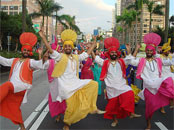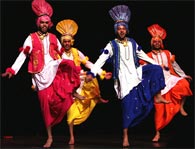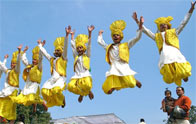BHANGRA
Origin
Bhangra is a traditional and lively form of folk dance which originated from Punjab. People in Punjab traditionally perform Bhangra while celebrating the harvest. During Bhangra, people sing Punjabi Boliyaan lyrics, at least one person plays the the dhol drum, and other people may play the flute, dholak drum, or other musical instruments. While Bhangra began as a part of harvest festival celebrations, it eventually became a part of such diverse occasions as weddings and New Year celebrations.Bhangra folk dance and music of the Punjab and the popular music genre which emerged from it in the mid-to-late 20th century. Today the newer bhangra blends various Western popular musics with the original Punjabi tradition. Bhangra enjoys an immense following in South Asia and within the South Asian diaspora. The celebration in India of Harvest and the Baisakhi Festival begins with the dance steps known as Bhangra. This tradition has been followed since 1947 - the year when India became Independent.
 Bhangra is one of the most significant traditions of the Punjabi culture because it symbolizes the imagination, talent, potential and charisma of Punjab's people. Illustrating the sowing of seeds, hoeing, cutting of wheat and the selling of crops in the beautiful choreography, this folk dance remains popular within the villages of the Gujranwalla, Gujrat, Shekhpura, Sialkot and Gurdaspur districts. Simple but vigorous, bhangra is a dance of enthusiasm and gaiety.
Bhangra is one of the most significant traditions of the Punjabi culture because it symbolizes the imagination, talent, potential and charisma of Punjab's people. Illustrating the sowing of seeds, hoeing, cutting of wheat and the selling of crops in the beautiful choreography, this folk dance remains popular within the villages of the Gujranwalla, Gujrat, Shekhpura, Sialkot and Gurdaspur districts. Simple but vigorous, bhangra is a dance of enthusiasm and gaiety. Bhangra dance, typically performed in a team, involves co-ordination, timing and technique amongst the various team members. Traditionally Bhangra in India is accompanied by the pulsating rhythm of the Dhol, the Algozeh, the Chimpta, the Tumbi and traditional folk songs sung by men and women.
 The Dhol plays an integral part of many Bhangra performances. The large, wooden, two-sided barrel drum, which is played with two thin curved cane sticks, provides distinct treble and bass sounds. The outcome of pulsating rhythm, in conjunction with Bhangra, brings together the elements of music and dance into its most expressive form captivating the attention of audiences of all ages.
The Dhol plays an integral part of many Bhangra performances. The large, wooden, two-sided barrel drum, which is played with two thin curved cane sticks, provides distinct treble and bass sounds. The outcome of pulsating rhythm, in conjunction with Bhangra, brings together the elements of music and dance into its most expressive form captivating the attention of audiences of all ages. Bhangra is a Punjabi folk dance which is massively popular all across the world. Historically, Bhangra is being celebrated during the harvest festival of Baisakhi in Punjab. Springing from the land of five rivers, it abundantly reflects the vigor, the vitality, the leaven of exuberance, and the hilarity permeated among the rural folk by the promise of a bumper crop. The Bhangra season starts with the wheat sowing and then every full moon attracts teams of young men in every village who dance for hours in open fields. Initially its reach was limited to Punjab only. But with the passage of time, it has attained huge fame outside Punjab also. Bhangra class and education, eventually becoming a part of weddings, New Year parties, and other important occasions.
Men wrap a four to six meter long Chadra or a silken cloth around the wrist along the coat and the headgear. Long shirts known as Kurtas are also worn. Women on the other hand wear a Ghagra - a long skirt. Dupattas - the colorful veils are also worn by the women.
Steps involved in the dance
Bhangra is all about symmetry, speed, balance, grace and fun. One of the most interesting thing about Bhangra is that its not just a single dance but it encompasses large number of sub genres as well. The major sub genres of Bhangra are Dhamal, Jhumar, Daankara, Luddi, Giddha, Julli, Gatka, Saami and Kikli. Gidda dance is stylistically simple with the Jingle of the bells, thumping of the feet, along with the beat of the drum and the resplendence of Punjabi women in salwar kameej creates an enchanting atmosphere for people visualizing it. The musical instruments used in Bhangra make rhythm of music very energetic and catchy.
Gidda dance is stylistically simple with the Jingle of the bells, thumping of the feet, along with the beat of the drum and the resplendence of Punjabi women in salwar kameej creates an enchanting atmosphere for people visualizing it. The musical instruments used in Bhangra make rhythm of music very energetic and catchy. Main instruments used in Bhangra are;
Sarangi, Dafli, Tumbi or Ektar, Dholak, Chimpta, Dhol and Damaru The traditional Bhangra consists of lively vivacious music with a distinct Dhol beat which gets people moving involuntarily. Right from its origin to the date, Bhangra has always evolved itself. Considered as a dance as well as a musical style, Bhangra has truly gone international. Bhangra is a very rich art form, which takes its cues from the folk roots of Punjab, its warriors and folklores. The sparkling colours, beats and rhythms of Bhangra can easily force anyone to shake their legs.
Popular dancers
Sukhshinder Shinda, Inderjit Nikku, Jagmohan Kaur, Jasbir Jassi and Jassi Premi Jas are some of the well known Bhangra Dancers.Where to learn Bhangra Dance
-
Extasy Institute of Fine Arts
#244, 2nd Phase, Beside New Gowtham College, 1st Stage, Manjunath Nagar
Rajaji Nagar, Bangalore – 560010 Landmark: Below Signware
Mobile: 9845052797
Email-id:[email protected]
- Trinity Academy for Dance & Music
Address: #1, Plot No. 26, Balaji Nagar Extension
Nanganallur, Chennai - 600061
Landmark: Behind Badhala Vinayagar Temple
Phone: 044-22248648 Mobile: 9940229353
Email-id: [email protected]
- Kalashatram
Address: #2-2-1160/1, Sri Suman Apartment, Tilak Nagar
Nallakunta, Hyderabad - 500044
Mobile: 9246224233
Email-id: [email protected]


